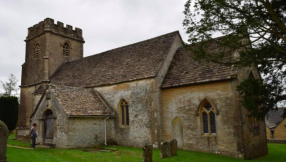A 2,000-year-old skeleton found in a tomb in northern Italy is offering some rare insights into crucifixion.
Researchers found "particular lesions" on the right heel of the skeleton, suggesting that the person was crucified.
The remains was reportedly found in 2007 during an excavation of an isolated tomb in northern Italy's Gavello municipality.
Researchers from the University of Ferrara and Florence examined the lesions and published the findings in the April 2018 edition of the journal Archaeological and Anthropological Sciences.
"Here we suggest crucifixion as a possible cause of the lesion, but this interpretation is complicated by the poor preservation of the bone surfaces and the damage and holes in other skeletal parts," the report stated, according to Express.
Experts have concluded that the man was between the ages of 30 and 34 at the time of the crucifixion. Radiocarbon dating had not been used to determine the age of the remains, but the location suggested that the man was buried around 2,000 years ago.
Further analysis revealed that the lesion had passed through the 'entire width' of the heel bone.
"The perforation (length 24 mm) shows a regular round hole passing from the medial side (diameter 9 mm) to the lateral one (diameter 6.5 mm). The pattern of the cross-sectional lesion is linear in the first part, turning slightly downward in the last part," the authors wrote, as reported by Express.
The experts suggested that the upper limbs of the victim had been "fixed to the cross by nails through the wrist, as per ancient historical sources."
The authors of the study further noted that the manner of the crucifixion resembled the traditional depiction of Jesus Christ on the cross.
The individual was buried directly in the ground without grave goods, suggesting that he was either in captivity or belonged to a marginalized portion of the population.
The skeleton is the only second known archaeological discovery that has been associated with a crucifixion.
Despite the numerous historical writings, tangible evidence associated with the form of execution has been rare.
The first archaeological evidence for crucifixion was found in an excavation in a cemetery in Jerusalem in 1968. The archaeologists found an ossuary containing the remains of a child aged between 3 and 4, and a man believed to be between the age of 20 and 24.
The heel bone of the man reportedly had an 18 cm. (7-inch) nail and some 1-2 cm. of olive wood, which were believed to be remnants of the cross.
Evidence for crucifixions has been scarce despite the technique being frequently used by the Romans. This is partly because the type of wood used by the Romans disintegrated quickly. Additionally, the nails used in the execution were often taken from the victim because some believed they had magical properties.













